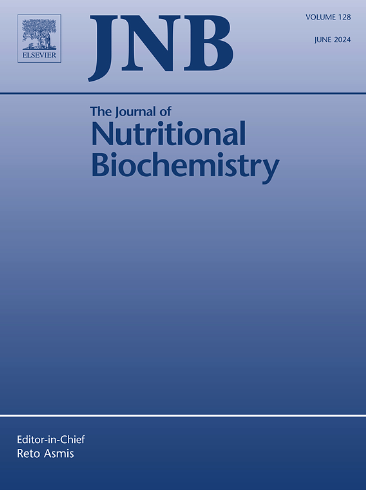锌氨基酸螯合物和芳烃受体(AHR)共同作用,改善Caco-2细胞肠上皮的屏障功能。
IF 4.9
2区 医学
Q1 BIOCHEMISTRY & MOLECULAR BIOLOGY
引用次数: 0
摘要
锌和芳烃受体(AHR)的一些生理相关配体是促进肠道屏障功能的营养物质。我们已经发现,AHR激活可上调肠上皮中锌输入蛋白的表达,从而增加细胞内锌浓度,从而改善上皮屏障功能。在这里,我们研究了锌的氨基酸螯合物,在AHR激活的合作下,是否可以改善分化的Caco-2细胞上皮的屏障功能。Caco-2细胞上皮的功能分析表明,ZnSO4和锌的赖氨酸和谷氨酸螯合物,与AHR生理激动剂6-甲酰基林多洛[3,2-b]咔唑(FICZ)联合使用,在mRNA和蛋白水平上增加了紧密连接蛋白的表达。在培养基中存在ZnSO4或氨基酸锌螯合物时,FICZ增加了上皮对锌的吸收,程度相同。我们得出结论,锌的赖氨酸和谷氨酸螯合物在降低FICZ存在时Caco-2细胞上皮通透性方面与ZnSO4一样有效。结果表明,在膳食中补充生物可利用形式的锌和营养性AHR激动剂可能有助于改善肠道屏障功能,并有助于预防炎症性肠病(IBD)。本文章由计算机程序翻译,如有差异,请以英文原文为准。

Zinc amino acid chelate and the Aryl Hydrocarbon Receptor (AHR) cooperate in improving the barrier function of a Caco-2 cell intestinal epithelium
Zinc and several physiologically relevant ligands of the aryl hydrocarbon receptor (AHR) are nutrients that promote intestinal barrier function. We have identified that AHR activation upregulates the expression of zinc importers in the intestinal epithelium to increase intracellular zinc concentrations, which leads to improved epithelial barrier function. Here, we investigated if an amino acid chelate of zinc, in cooperation with AHR activation, can improve the barrier function of a differentiated Caco-2 cell epithelium. Functional assays of the Caco-2 cell epithelium demonstrate that both ZnSO4 and a lysine and glutamic acid chelate of Zn, in combination with the physiological AHR agonist 6-formylindolo[3,2-b]carbazole (FICZ), increase expression of tight junction proteins at the mRNA and protein levels. FICZ increases uptake of zinc into the epithelium in the presence of ZnSO4 or the amino acid Zn chelate in the medium to equal extents. We conclude that the lysine and glutamic acid chelate of Zn is as efficacious as ZnSO4 in reducing permeability of the Caco-2 cell epithelium in the presence of FICZ. The results suggest that dietary supplementation with bioavailable forms of zinc together with nutritional AHR agonists may be beneficial in improving gut barrier function and help prevent inflammatory bowel disease (IBD).
求助全文
通过发布文献求助,成功后即可免费获取论文全文。
去求助
来源期刊

Journal of Nutritional Biochemistry
医学-生化与分子生物学
CiteScore
9.50
自引率
3.60%
发文量
237
审稿时长
68 days
期刊介绍:
Devoted to advancements in nutritional sciences, The Journal of Nutritional Biochemistry presents experimental nutrition research as it relates to: biochemistry, molecular biology, toxicology, or physiology.
Rigorous reviews by an international editorial board of distinguished scientists ensure publication of the most current and key research being conducted in nutrition at the cellular, animal and human level. In addition to its monthly features of critical reviews and research articles, The Journal of Nutritional Biochemistry also periodically publishes emerging issues, experimental methods, and other types of articles.
 求助内容:
求助内容: 应助结果提醒方式:
应助结果提醒方式:


